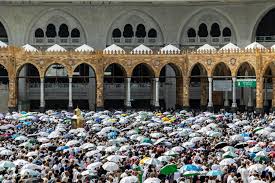Diplomats have reported that at least 550 pilgrims died during this year’s Hajj, mainly due to illnesses caused by extreme heat. The highest number of fatalities were Egyptians, with 323 deaths, followed by additional fatalities reported by Jordan and other countries, raising the total death toll to 577.
The temperatures during the pilgrimage were incredibly high, reaching up to 51.8 degrees Celsius (125 Fahrenheit) at the Grand Mosque in Makkah. This extreme heat made the situation worse, causing severe heat-related illnesses among the pilgrims.
Saudi authorities had to treat over 2,000 pilgrims for heat stress. However, the services were overwhelmed, and many unofficial pilgrims, who lacked proper amenities, also contributed to the high number of deaths.
Approximately 1.8 million people participated in this year’s Hajj, and many faced difficult conditions, especially during the rituals, such as praying on Mount Arafat. Despite being advised to stay hydrated and use umbrellas for shade, pilgrims had to endure long hours outside in the scorching heat.
The presence of unauthorized pilgrims, who often did not have access to adequate services, added to the overall chaos. While Saudi health officials claimed that they managed heat-related illnesses and prevented diseases effectively, the overall situation highlighted the growing impact of climate change on the Hajj pilgrimage.
The extreme weather conditions made it increasingly challenging for pilgrims to perform their religious duties safely.


